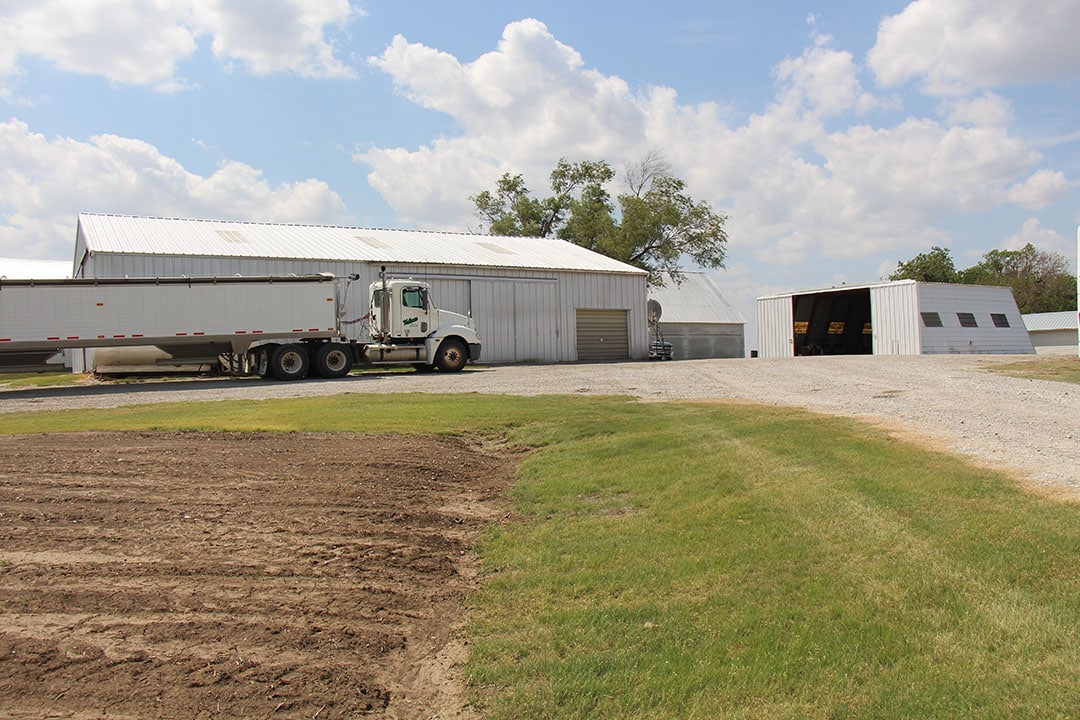This is how Wellman Farms manages data, drought and water

Steve and Susan Wellman have adapted their way of farming to manage drought and water on 700 hectares in Nebraska. Automated data collection and storage is part of it and made them switch their combine brand.
Farming can be harsh in America’s third largest agricultural state Nebraska. Especially this year, with the month of May being the driest May on record since 1857! While normally May is the wettest month of the growing season, as we were told by one of the farmers we visited.
Nebraskan agriculture however has a trick up its sleeve called the ‘Ogallala aquifer’ (see box). An underground layer of mostly water bearing permeable rock from which groundwater is extracted for irrigation (and drinking water). The amount of underground water is comparable to a layer of almost 38 feet (11.6 metres) covering the whole state! No wonder Nebraska is home to four of the world’s largest manufacturers of centre pivot systems.
Text continues below picture

One inch less precipitation every 25 miles West
Future Farming had the opportunity to visit Wellman Farms near Syracuse, Nebraska on the invitation of the US Sustainability Alliance (USSA). Wellman Farms is a third-generation family farm run by Steven Wellman and his wife Susan. Steve is the former director for the Nebraska Department of Agriculture and farms about 700 hectares (1,730 acres) of owned and rented mostly silty clay loam land. “We used to farm 900 hectares but due to my other work and responsibilities, we diminished a bit”, Steve says. Their farm size still is way above the average arable farm size in Nebraska of 405 hectares (1,000 acres). All the work on the farm is done together with one fulltime employee.
The crops in Syracuse, mainly maize and soybean, can count on 30 to 32 inches (760 – 813 millimetres) of rainfall annually. This suffices not to irrigate on Wellman’s farm. “Every 25 miles you go west, the amount of rainfall drops 1 inch. In Western Nebraska, annual rainfall is as little as 10 inches (254 mm).”
50 percent less fuel with no till
Wellman Farms maintains a 1:2 rotation of maize and soybean and also grows a bit of alfalfa and winter wheat. “Over the years, we’ve moved away from grain sorghum. We still have some wheat but not as much as we used to have.” All crops are genetically modified. Apart from cropping, a 50 head cow-calf herd is kept. Mostly black angus. “That 50 head is slightly above the Nebraskan average of 40 heads”, Steve says.
The Wellmans switched to no-till in the mid-1980s
For sustainable but also for financial and workflow related reasons, the Wellmans switched to no-till in the mid-1980s. It resulted in a whopping 50 percent fuel reduction. Most fields are cultivated three times. When it comes to maize, they plant varieties with different harvest periods and normally harvest from mid-September to mid-November. “We do this to be able to harvest the total acreage with our John Deere S 760 combine and because we can then ship our cattle from field to field to feed on the maize residue.”
Interestingly enough, that combine used to be a red one. Steve explains: “When I was looking to buy a self-propelled sprayer, I became aware of the importance and benefits of automated data collection and cloud storage. Because of that, I chose to buy a John Deere sprayer and started using the Deere Operations Centre. This also resulted in trading in my red combine for the S 760 at AKRS Equipment, the local John Deere dealer.”
Contour terraces and waterways
The majority of the farmland is highly erodible and has therefor always had contour terraces and grass waterways. “That also adds to conservation and sustainability because the land, the soil, is our main resource. All three generations have been spending a lot of time and money on maintaining our terraces and waterways and on building drainage/tile systems to run water underground. By planting crops, we conserve water, soil and nutrients. That really is a difference compared to the 1970’s and ’80’s.”
Nebraskan farmers are used to insuring their crops, their yields, Steve says. “I believe that 95 to 96 percent of the crops are insured nowadays. With the yields based on the average yields over the last 10 years. Farmers have seen their yields more than double over the last 40 years. We currently harvest 150 bushels of maize per acre (9.4 ton/ha) and 45 bushels of soybean per acre (3.0 ton/ha).” Steve concludes that the acreage of maize in Nebraska has increased by 20 percent since 1980 and that the acreage of soybeans has doubled.
More pictures of Wellman Farms

Apart from cropping, a 50 head cow-calf herd is kept. Mostly black angus. From mid-September to mid-November they feed on the maize residue on the fields after harvesting.

The majority of the farmland is highly erodible and has always had contour terraces like this. “It adds to conservation and sustainability because the land, the soil, is our main resource. All generations have been spending a lot of time and money on maintaining our terraces and waterways.”

Drainage systems and grass waterways below the contour terrace and a strip of wheat left on the right upper hand. That strip is left for the insurance company in case a claim has to be made.



